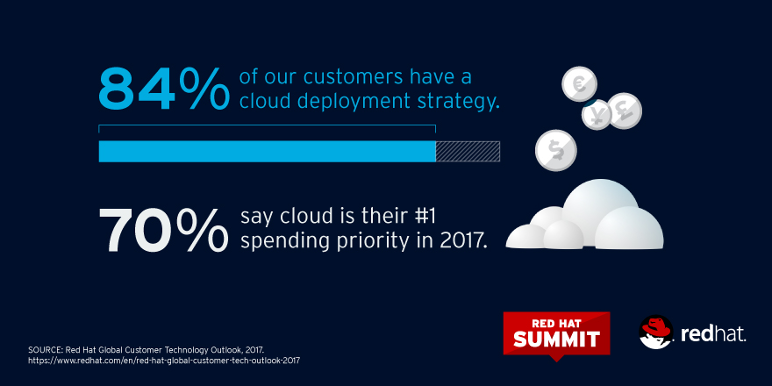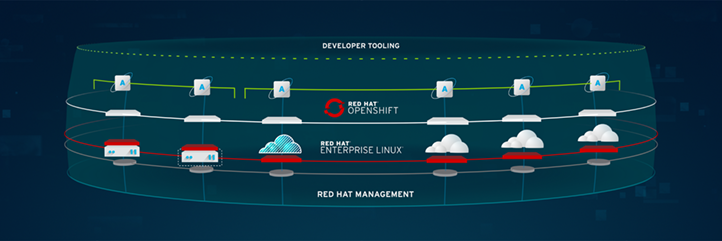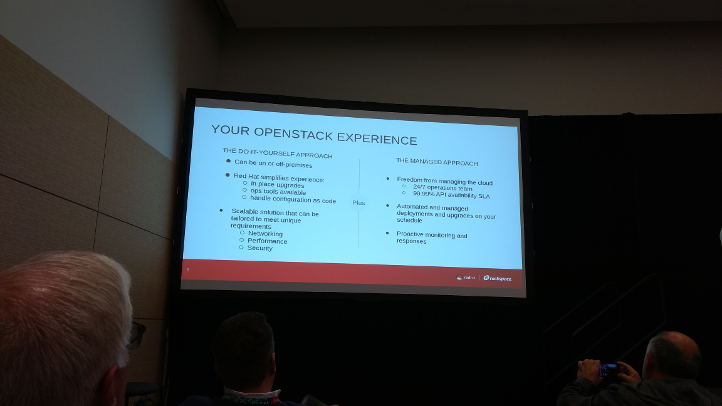Red Hat ブログ
Red Hat® Summit 2017’s opening general session was all about hybrid cloud. Paul Cormier, executive vice president and president of Products and Technologies at Red Hat, said 70% of our customers name cloud as a top spending priority. But, according to Cormier, hybrid cloud success isn’t just about the technology; it’s about strategy. That’s where Red Hat comes in: with technology that can move other IT resources in sync with hybrid cloud migrations.

“The hybrid cloud is Linux® [and] open source is the only way to solve the challenges of hybrid cloud.” - Paul Cormier
The big announcements during this opening keynote were both related to cloud. First, Red Hat announced its partnership with Amazon to package Amazon Web Services (AWS) within Red Hat OpenShift.
And, as Cormier mentioned, cloud-native app development is also key. The next announcement revealed OpenShift.io, an online, no-cost development environment for creating cloud-native, container-based apps with just a browser—no command-line coding or software.
Tuesday’s breakout sessions followed this news with a focus on how to make cloud app development and management easier and faster. Here are some highlights:
The future of datacenters is—surprise—in the cloud
If, as Stephen Watt from Red Hat’s Office of Technology stated in his morning session, “with Kubernetes, the cluster is now your computer,” then the cloud is your new datacenter.
“By 2025, 80% of all workloads will run on the public cloud.” - Citigroup analyst report, noted in presentation
But as the world of enterprise IT moves from physical to virtual, container-based environments, cloud isn’t immune to vendor lock-in. Amazon Web Services (AWS) speeds time to market with its expansive Service Catalog, but those services don’t directly translate to other providers’ offerings.
Watt and Chris Wright, vice president and chief technologist in the Office of Technology, shared Red Hat’s plans to support alternatives that include:
- Improving app portability across cloud providers―for example, by investing in Kubernetes Federation, the container orchestration manager that manages multiple clusters through a single interface.
- Offering a wider ecosystem of services to Kubernetes apps through Kubernetes Service Broker/Service Catalog.
Wright’s demo used high scores from a video game application as an example of app portability across providers with Kubernetes Federation. A containerized version of the app was deployed with MongoDB in Kubernetes, then clusters for AWS, Google Cloud Platform, and Microsoft Azure were connected to Kubernetes Federation Control Panel. The app can be ported to and from AWS, Google Cloud Platform, and Microsoft Azure without downtime or data loss.
So as cloud and containers take over, the provider lock-in battle isn’t over. But options for easier integration and migration can speed development and deployment in public, private, or hybrid clouds.
Red Hat CloudForms 4.5 includes default Ansible automation
But wait, there’s more. Additional big cloud news was discussed at the Red Hat CloudForms roadmap session. According to John Hardy, Brad Ascar, and Loic Avenel, product managers for Red Hat CloudForms, automation is happening for different IT resources and across environments, but these efforts are limited and isolated.
“Automation is good but ... [a]utomated silos are still silos.” - John Hardy, Brad Ascar, and Loic Avenel
To unite automation efforts, Red Hat CloudForms 4.5 will include Ansible as the default automation language. Users can take advantage of role-based access―no extra setup or subscriptions needed―to work faster with reusable playbooks.
This update will add support for more than 900 integrations and include a self-service catalog for a variety of management needs, such as:
- Ordering apps, Infrastructure-as-a-Service (IaaS), containers, and automation resources.
- Helping to ensure a playbook can execute in your datacenter.
- Managing and performing chargeback.
- Detailed user feedback.
- Quota management.
Governance and policy state management through the integrated combination of Red Hat CloudForms can also provide event-based management to monitor and proactively protect clusters. And Red Hat CloudForms will use Ansible automation to track changes and launch playbooks in response, adjusting other related settings using those playbooks.
In the demo, the presenters showed how Red Hat CloudForms adds intelligence to Ansible’s automation strengths. In version 4.5, Red Hat CloudForms can identify and link the playbooks used to deploy Ansible. You can add custom buttons in Red Hat CloudForms’ management console that link directly to specific playbooks, helping to make development faster by adding to the product’s standard resources and capabilities.
A solution for the public vs. private cloud debate
The great thing about cloud computing―and why its adoption has accelerated―is its massive possibility. No matter your IT needs, there’s some form of cloud that can help you work faster with less staff, lower costs, and fewer resources.
According to Red Hat’s Jonathan Gershater, senior principal product manager, and Kevin Jones, cloud solution architect for public sector, different cloud models offer different advantages depending on your budget, company size, and needs.
Private cloud:
- Large initial outlay with more predictable, long-term model that’s suitable for budgeting and planning (CapEx model)
- Requires employees to manage because it’s hosted in your datacenter
- Hard to reuse resources
- Offers higher security because attacks are limited to your datacenter, but you and your vendors are in control and responsible for resolving issues
Public cloud:
- Well-suited for startups that don’t want to invest in hardware and enterprises that want to become more agile and reduce CapEx
- Faster time to market but less- predictable costs and more lock-in due to application programming interface (API) variety
- Vendor-owned and managed infrastructure, but shared and less secure
A decision-making flowchart showed how to decide what type of cloud to deploy and which Red Hat products to use. One that can offer the most flexibility and simplest management at low cost? Gershater and Jones say an open hybrid cloud built with Red Hat technology from across our portfolio, including Red Hat Cloud Suite.

To see an example of a successful open hybrid cloud, check out Cox Automotive’s journey to managing infrastructure in the cloud and delivering self-service access for faster resource delivery.
Running your business instead of your cloud
According to Dan Sheppard from Rackspace, choosing a private cloud doesn’t mean sacrificing the agility and flexibility of public cloud. Combining OpenStack® with a managed service model means getting the best of both environments.
A public cloud is good for fewer machines, but by-the-hour billing makes them costly for larger deployments. There’s strategic value in controlling your instances, data, and machines, but someone has to manage all that.

When you expect your API to just work in the cloud―or want an AWS-like experience in your datacenter―you’re looking for a managed service experience. Managed services like Rackspace Private Cloud Powered by Red Hat (RPC-R) offer public cloud agility to scale on demand without the higher risk. Operations can control costs and provide resources, while developers can focus on their work instead of managing your cloud.
Boston’s clouds are clearing up, but there’s more cloud to come at Summit
There were many more cloud sessions and talks from partners, customers, and Red Hat on day 1 of Summit, and more to come in the next 2 days of the leading open source conference. As Cormier said in his keynote, this is the environment of the future, and Red Hat and our partners are here to lead you past all the potholes and sharp curves on your path to a cloud-native future―no matter what your cloud looks like.
Check out our blog on day 1 of infrastructure at Summit for more cloud infrastructure highlights. On site in Boston? Join us for more cloud sessions, labs, and training.
About the author
Red Hat is the world’s leading provider of enterprise open source software solutions, using a community-powered approach to deliver reliable and high-performing Linux, hybrid cloud, container, and Kubernetes technologies.

